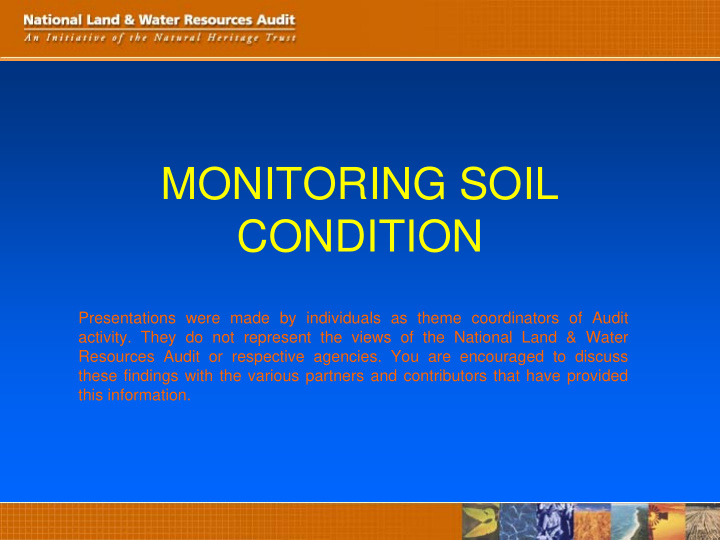



MONITORING SOIL CONDITION Presentations were made by individuals as theme coordinators of Audit activity. They do not represent the views of the National Land & Water Resources Audit or respective agencies. You are encouraged to discuss these findings with the various partners and contributors that have provided this information.
Wind erosion
Water erosion
5.0 4.0 5.0 8.2 Soil acidification
Soil carbon change (SOC)
The NM&EF’s requirement was to monitor • Progress towards community outcomes (roll-up ?) • Progress towards national outcomes
The NLWRA’s task was to • Advise on suitable indictors • Develop protocols • Identify information needs
So the NCST…. • Convened panels to advise on monitoring – Wind & water erosion, pH and SOC change • Field tested the recommendations • Drafted four protocols • Considered the information pre-requisites for monitoring (SNRI)
From the Expert Panels – techniques fall into 3 complementary categories Ground observations Surveys of land use and land management practices MONITORING TECHNIQUES Modelling Remote sensing
And.… • ‘ Roll-up’ unlikely • No single technique perfect • Both low tech and high tech • Some techniques require standardisation • Some techniques require more development
Short Medium Long CEMSYS CEMSYS CEMSYS National SedNET SedNET SedNET pH models pH models SOC models SOC models Roadside survey Roadside survey Roadside survey Regional SedNET SedNET SedNET pH sites pH sites SOC sites SOC sites LU/LMP surveys LU/LMP surveys LU/LMP surveys Local
From the trials …. • Changing organisational structures • “Thin” skill base • Important to share • IP gets in the way • Development required – ASRIS, MIR, Stats, SedNET, reporting products
From the information requirements …. • Soils • Land use • Land cover • Climate • Topography
Data required Soil Soil carbon Soil erosion Soil erosion acidification change by wind by water * * * * * * * * * * * Soil profile data (depth, texture, pH CEC etc) * * * * * * * * * * * Soil polygon data (distribution , landform etc) * * * * * * * * Land use * * * * * * * * * * * * Land management practices * * * * * * * * * * * Crop yields * * * * * * * * Land use and land management statistics * * * * * * * * * * Annual vegetation type, % cover, extent * * * * * * * * Perennial vegetation type, % cover, extent * * * * * * * * * * Climatic parameters (rainfall, temperature, wind, evaporation, visibility) * * * * * * * * * Parameters estimated from soil and climatic data (soil moisture, soil temperature) Digital elevation models including surface * * * * * hydrology * * * * * * ‘Micro topography’ (boundary layer roughness, ground surface particle size)
DAFF/DEWHA National Committee Scientific Advisory Panel for Soil and Scientific development of soil condition Terrain monitoring Links with state agencies National soils policy In-profile processes Surface processes Manage ASRIS (pH & SOC) (Wind & water Career development erosion) Contextual data To be developed Research OBSERVATION REMOTE SENSING MODELLING CHAMPIONS CHAMPIONS CHAMPIONS
And the champions for wind & water are …. REMOTE MODELLING OBSERVATION SENSING CEMSYS - USQ Super sites - CSIRO/BOM Fractional cover - GA SedNET - CSIRO L&W Dustwatch nodes - NSW Dust Sentinel - CSIRO AussiGRASS - QDPI DECC LIDAR - GA Roadside observation - Eroded land imaging - NSW/SAG CSIRO CMIS Soil loss plots – QDNR
Conclusions …. • Significant progress has been made • Australia is still not well equipped to report on – Local progress – National soil condition and change (pH = MDB ?) • Require – Clear long term goals – National leadership and organisation – Time and (some) dollars
Do you have any questions Thank you
Recommend
More recommend